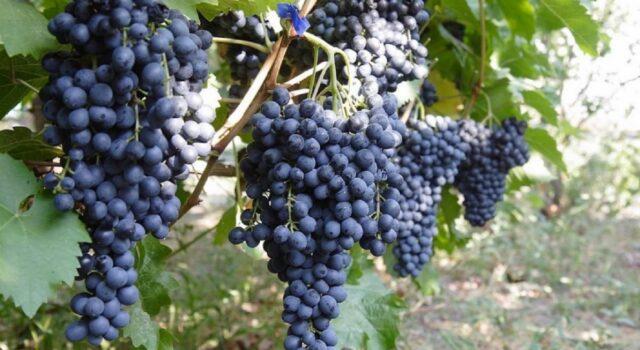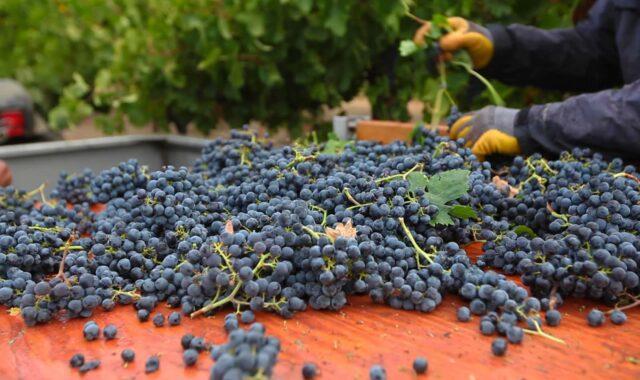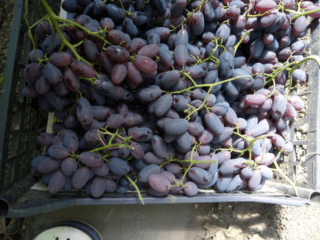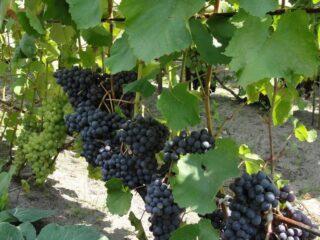Content
Krasen grapes are a hybrid of generative selection intended for industrial cultivation and private cultivation. Medium ripening variety, unpretentious, frost-resistant. The berries are universally used and are characterized by a high sugar content. The Krasen hybrid is early ripening and produces single clusters the next year after planting. Peak fruiting reaches at the age of three years.
History of appearance
The grapes were created on the basis of the Crimean Research Institute "Magarach", specializing in the development of new varieties for the development of viticulture and winemaking. Antey Magarachsky (Magarach No. 70/71/52) and ultra-early white Magarach, previously obtained by generative hybridization, were taken as a basis. As a result, a table-technical seedless variety Krasen with good yield and frost resistance was obtained. In 2008, the institute introduced a new hybrid, and the grapes were assigned patent No. 06285.
Description of Krasen grape variety
The variety was created for cultivation on an industrial scale. Kishmish grapes (seedless) Red mixed type. It is classified as a technical variety and is widely used for making wine.

Due to its high nutritional value and taste, the variety is closer to table varieties
Bunches
Fruit clusters of Krasen grapes of medium density. The shape is conical with a side wing, pointed downward. The main formation is noted at the tops of perennial and current season shoots. Weight depends on weather conditions and growing method. Cultivation in a protected way is less productive; bunches of Krasen grapes weigh 400-600 g. In open areas they can reach 1 kg. The average length of a fruit raceme is 15-20 cm, diameter is up to 18 cm.
Berries
What do Krasen grape fruits look like:
- the shape is round, slightly elongated, the berries are tightly attached to the stalk, and do not fall off after ripening;
- the color is dark blue closer to black;
- weight – 3-4 g;
- diameter – 12 mm;
- the peel is elastic, thin, with a waxy matte coating, does not crack;
- the pulp is dark red, the juice is burgundy;
- seeds in the form of rudiments are not even found in all fruits.

Krasen grapes are not prone to peas, all berries are of an even shape and the same weight
Vine
The variety is tall, the crown is dense with numerous foliage and lateral shoots. Without length correction, the vine of the Krasen variety grows up to 3-4 m in a season, the fruits are formed on stems of the first and second order.
External description:
- the perennial vine is thick, with a woody structure;
- the bark is dark brown, partially peeling, hard, with a rough surface;
- young shoots are dark green, smooth, thin;
- the leaves are five-segmented, large, slightly dissected, with carved edges, located on short petioles.

The Krasen variety is self-pollinating, therefore it is famous for its good yield.
Characteristic
The grapes borrowed the best qualities from their predecessors. All buds are characterized by good blooming. If the stems are damaged, Krasen bears fruit even on replacement shoots, so the yield is always stable.
The stress-resistant plant calmly tolerates sudden temperature changes and does not require special attention. Agricultural technology for the variety is standard. The self-pollinating hybrid Krasen is grown in open and closed ways. It is suitable for areas with cold climates.
Ripening period of Krasen grapes
The variety is mid-season; harvest time depends on the region. The honeycomb characteristics of the Krasen grapes indicate that the berries reach biological ripeness in 140 days. This is provided that the grapes grow in a warm climate. Fruits are harvested in the southern regions in the second half of August. In temperate climates, Krasen grapes ripen later and are harvested at the end of September.
Productivity
Full fruiting is possible only with sufficient heat and light. In closed structures, the necessary indicators are artificially created. On farmers' fields, the yield is 180-185 centners per 1 hectare.

A good harvest is possible only if the requirements of agricultural technology are met.
Sugar content of Krasen grapes
In terms of its taste characteristics, the Krasen hybrid is not inferior to dessert varieties. The taste is rich, with a slight muscat tint.The concentration of sugars depends on how warm and sunny the season was. The average is 35 g/100 m3. In winemaking, the wort yield is 80-85%.
Growing regions
The most comfortable conditions for the growth of Krasen grapes are the Krasnodar and Stavropol regions, the southern part of the Rostov region, and Crimea. The variety is cultivated in open ground without additional shelter for the vine for the winter. Krasen feels good in unheated greenhouses in the Urals and Siberia (Barnaul, Novosibirsk Omsk, Tyumen), provided that the covering material is removed when the temperature is stable at +15 0C. With additional protection from return frosts in an open area, the hybrid grows and produces a good harvest in the Moscow region, Voronezh, Cherkassy, Tambov, Kursk regions.
Frost resistance
The growing season begins when the soil warms up to +100 C, if an adult plant is damaged by possible frosts, then the grapes quickly form a replacement. But it is better not to allow this, because the yield will be lower and ripening will be later. For a heat-loving southern culture, Krasen is quite frost-resistant. Without additional insulation of the vine and root system, an adult plant can withstand up to -26 0C. Young grapes are less stable, their indicator reaches -18-20 0C.
Drought resistance
Krasen grapes are a drought-resistant crop. The plant requires a large amount of moisture at the beginning of sap flow and at the end of the season. The root system is powerful, deep up to 5 m, and fully supplies the plant with water. Seasonal rainfall is sufficient for the hybrid. In dry summers the norm is 60 liters for 20 days.
Resistance to diseases and pests
The hybrid is genetically endowed with high resistance to infections.In damp and cold summers, infection with the following diseases is possible:
- Gray rot. The plant is sprayed with Bordeaux mixture and problematic brushes are removed.
- Mildew (downy mildew) affects the fruits and crown, manifesting itself as yellow, then red spots on the leaves. To prevent disease, the bush is treated with copper sulfate in the spring. At the first signs, use Bordeaux mixture.
- Anthracnose is localized first on the leaves. The infection is identified by red raised areas, in the place of which holes subsequently appear. Copper oxychloride-based products are effective against fungal infections.
Of the pests on Krasen grapes, only the grape budworm is parasitized.

Destroy the larvae using “Promark” or “Match”
Methods of application
The Krasen variety is universal. In addition to winemaking, it is used for making juice. Prepared for the winter in the form of compote, marmalade, jam or preserves.
Advantages and disadvantages
Any variety has its own advantages, for which gardeners love it. Before planting a crop, it is necessary to identify its strengths and weaknesses.

The main positive quality of Krasen grapes is a high concentration of sugars, which allows the crop to be used for winemaking
Pros:
- stable fruiting;
- good taste;
- frost resistance and drought resistance;
- the berries do not crack;
- the hybrid is not attacked by wasps;
- immunity to disease;
- Possibility of growing indoors and outdoors.
The disadvantages include a short shelf life, the need for pruning and fixing to a trellis.
Landing Features
For Krasen grapes, southern slopes with aerated soil are allocated. Planting is carried out in April, when the soil warms up to +8-10 0C.
Sequence of work:
- They dig a hole in advance 90-100 cm deep, 10-15 cm wide than the volume of the root.
- The bottom is covered with a drainage cushion.
- Mix organic matter, topsoil, peat or sand, add superphosphate and ash.
- ½ part of the nutrient substrate is poured onto the bottom.
- The Krasen grape seedling is disinfected in a manganese solution and placed in the center. Cover with the rest of the mixture.
- Prune Krasen grapes to the fourth fruit bud.
- Install a trellis.

When planting linearly, the interval between Krasen grape seedlings is 3.5-4 m
Rules of care
High yields can only be achieved by following the rules of agricultural technology.
Basic requirements for crop care:
- In the first year, water the young plant once a week with a volume of 5-10 liters of water. An adult bush has enough rainfall. In autumn, moisture-recharging irrigation is carried out.
- Constantly loosen the root circle and remove weeds.
- The first two years of the growing season do not feed the grapes. Subsequently, before flowering, nitrogen-containing agents are added, during the formation of berries - saltpeter, at the time of ripening - potassium and phosphorus. Liquid organics are used without limitation.
- In the third growing season, formative pruning is carried out and the Krasen grape vine is tied to a trellis.
In autumn, remove the stems from the support and cut off dry shoots. Boards are placed near the bush, and grapes tied in a bunch are placed on them. Install arches, stretch covering material, cover with spruce branches or snow.

The structure is erected after the temperature drops to -5 0C; before this time, the seedling must undergo natural hardening
Conclusion
Krasen grapes are a seedless table variety. Created for cultivation not only in the south, but also in regions with a temperate climate. The hybrid is characterized by strong immunity, drought resistance, and standard agricultural technology.
Reviews of Krasen grapes











